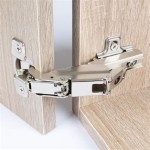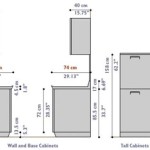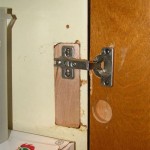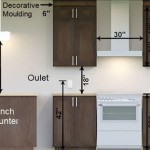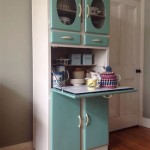How To Remove Mold From Inside Kitchen Cabinets
Mold growth inside kitchen cabinets is a common household problem, particularly in areas with high humidity or where leaks have occurred. Mold not only poses a health risk to occupants but can also damage the structural integrity of the cabinets themselves. Therefore, addressing mold promptly and effectively is crucial. This article will provide a detailed guide on how to safely and thoroughly remove mold from your kitchen cabinets.
The presence of mold is often indicated by a musty odor or visible discoloration. Small patches may appear as fuzzy or slimy spots, ranging in color from white and green to black. If such signs are detected, immediate action is necessary to prevent further spread and potential health complications. This article focuses on removing surface mold. Extensive infestations or mold growth within the cabinet material itself may require professional remediation.
Prior to initiating the cleaning process, it is imperative to understand the potential health risks associated with mold exposure. Mold spores can cause allergic reactions, respiratory problems, and other health issues, especially in individuals with pre-existing conditions such as asthma or compromised immune systems. Therefore, adequate safety precautions must be taken to minimize exposure during the removal process.
Safety Precautions Before You Start
Ensuring personal safety is the first and most crucial step in mold removal. Before commencing any cleaning activities, appropriate protective gear is essential. This gear creates a barrier between the individual and the mold spores, minimizing the risk of inhalation, skin contact, and eye irritation.
Eye protection is paramount. Safety goggles, preferably those that form a tight seal around the eyes, are crucial to prevent mold spores from entering. Regular eyeglasses are usually insufficient as they do not provide complete protection from airborne particles. The goggles should be cleaned thoroughly after each use to avoid cross-contamination.
Respiratory protection is equally important. A properly fitted N-95 respirator or a more advanced respirator with HEPA filters is recommended. This type of respirator filters out a significant percentage of airborne particles, including mold spores. It is vital to ensure that the respirator fits snugly around the nose and mouth to create a proper seal. Users should familiarize themselves with the manufacturer's instructions for proper usage and maintenance of the respirator.
Skin protection is also necessary. Wearing disposable gloves, such as nitrile or rubber gloves, is recommended to prevent mold spores from coming into contact with the skin. A long-sleeved shirt and pants should also be worn to cover as much skin as possible. After the cleaning process, it is important to dispose of the gloves properly to prevent the spread of mold spores.
Ventilation is crucial for minimizing the concentration of airborne mold spores. Open windows and doors to allow for fresh air circulation. If possible, use a fan to direct air out of the room and away from other living areas. This helps to reduce the amount of mold spores circulating in the air and minimizes the risk of inhalation.
Finally, consider sealing off the work area from the rest of the house. This can be achieved by using plastic sheeting and duct tape to create a barrier around the affected area. This will help to contain the mold spores and prevent them from spreading to other parts of the house. Ensure that the plastic sheeting is properly secured to prevent any gaps or leaks.
Cleaning Solutions and Methods
Selecting the appropriate cleaning solution is critical for effectively removing mold from kitchen cabinets. Several options are available, each with varying degrees of effectiveness and suitability for different surfaces. It is essential to choose a solution that is both effective in killing mold and safe for the cabinet material.
A solution of diluted bleach is a common and effective mold-killing agent. It is important to note that bleach should never be mixed with ammonia or other cleaning products, as this can create toxic fumes. A recommended concentration is one part bleach to ten parts water. This solution can be applied to non-porous surfaces, such as laminate or painted cabinets. However, it is crucial to test the solution on an inconspicuous area first to ensure that it does not damage or discolor the surface.
White vinegar is a natural and less harsh alternative to bleach. It is effective in killing a variety of mold species and is generally safe for most surfaces. Undiluted white vinegar can be sprayed directly onto the mold-affected area and allowed to sit for an hour before wiping it clean. The strong vinegar smell will dissipate over time.
Baking soda is another natural and effective mold remover. It can be used to neutralize odors and absorb moisture, which can help to prevent mold growth in the future. To use baking soda, mix it with water to create a paste. Apply the paste to the mold-affected area and let it dry completely. Then, scrub the area with a brush and wipe it clean.
Hydrogen peroxide is a non-toxic alternative to bleach that can effectively kill mold. A 3% solution of hydrogen peroxide can be sprayed directly onto the mold-affected area and allowed to sit for 10 minutes before wiping it clean. Hydrogen peroxide may have a bleaching effect, so it is important to test it on an inconspicuous area first.
Tea tree oil is a natural fungicide that can be used to kill mold. Mix two teaspoons of tea tree oil with two cups of water in a spray bottle. Spray the solution onto the mold-affected area and let it sit for an hour before wiping it clean. The strong smell of tea tree oil will dissipate over time.
Regardless of the cleaning solution chosen, it is important to use a soft brush or sponge to scrub the mold-affected area gently. Avoid using abrasive cleaners or scrub pads, as these can damage the surface of the cabinets. After cleaning, thoroughly dry the area with a clean cloth. Ensure that the cabinets are completely dry before replacing any items inside.
Preventing Future Mold Growth
Preventing future mold growth in kitchen cabinets requires addressing the underlying causes of moisture and maintaining a clean and dry environment. Implementing several strategies can significantly reduce the risk of mold recurrence.
Identifying and addressing the source of moisture is the most critical step. Leaky pipes, dripping faucets, and inadequate ventilation can all contribute to moisture build-up inside cabinets. Regularly inspect under sinks and around plumbing for any signs of leaks. If leaks are detected, repair them promptly.
Improving ventilation is essential for reducing humidity levels. Ensure that the kitchen is properly ventilated by using exhaust fans while cooking and washing dishes. Opening windows can also help to increase air circulation. Consider using a dehumidifier in areas with high humidity levels.
Maintaining clean and dry cabinets is crucial for preventing mold growth. Regularly clean the inside of cabinets with a mild detergent and water. Pay particular attention to spills or food residue, as these can provide a food source for mold. Ensure that the cabinets are completely dry after cleaning.
Using moisture-absorbing products can help to control humidity levels inside cabinets. Desiccants, such as silica gel packets or charcoal briquettes, can absorb excess moisture and prevent mold growth. Place these products inside cabinets, particularly in areas prone to moisture build-up. Replace or recharge the desiccants regularly as needed.
Proper food storage is also important for preventing mold growth. Store food in airtight containers to prevent spills and leaks. Regularly check expiration dates and discard any spoiled food promptly. Avoid storing damp or wet items inside cabinets.
Consider applying a mold-resistant coating to the inside of cabinets. These coatings can help to prevent mold from growing on the surface of the cabinets. Choose a coating that is specifically designed for use in kitchens and is safe for contact with food.
Regularly inspect kitchen cabinets for any signs of mold growth. Early detection is key to preventing a widespread infestation. If mold is detected, address it promptly using the cleaning methods described earlier in this article.

Causes Of Mold In The Kitchen And How To Avoid It Home Matters Ahs

How To Remove Mold In Kitchen 100 Doable The Insider

How To Remove Mold From A Wood Cabinet

How To Clean Mold In Kitchen Cabinets Servicemaster Re

Cabinets Around The House How To Remove Mold From Wood

How To Find The Source Of Mildew Mold Hometalk

How To Remove Kitchen Mold Puroclean Hq

3 Places Mold Damage Strikes Most Often And How To Remove It Safely

How Long Should A Central C Unit Last Crawford Mech

How To Clean Mold Off Interior Wood Under My Kitchen Sink Hunker
Related Posts


